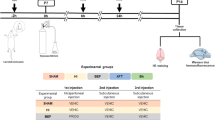Abstract
Progesterone is an efficient candidate for treating stroke and traumatic brain damage. The current study was designed to investigate the effects of progesterone on glucose transporter proteins (GLUT1 and GLUT3) during hypoxic-ischemic injury in a neonatal rat model. We demonstrated strong staining for GLUT1 in the walls of blood vessels and GLUT3 immunoreactivity in hippocampal neurons after hypoxiaischemia. Hypoxia-ischemia elevated GLUT1 and GLUT3 at both the mRNA and protein levels in the hippocampus, and pre-treatment with progesterone (8 mg/kg) further enhanced their accumulation until 24 h after hypoxic-ischemic injury. These results showed that progesterone treatment induced the accumulation of both GLUT1 and GLUT3 transporters, and an energy-compensation mechanism may be involved in the neuroprotective effect of progesterone during hypoxic-ischemic injury after cerebral ischemic attacks.
Similar content being viewed by others
References
Dirnagl U, Iadecola C, Moskowitz MA. Pathobiology of ischaemic stroke: an integrated view. Trends Neurosci 1999, 22: 391–397.
Wang Y, Denisova JV, Kang KS, Fontes JD, Zhu BT, Belousov AB. Neuronal gap junctions are required for NMDA receptormediated excitotoxicity: implications in ischemic stroke. J Neurophysiol 2010, 104: 3551–3556.
Koizumi H, Fujisawa H, Suehiro E, Shirao S, Suzuki M. Neuroprotective effects of ebselen following forebrain ischemia: involvement of glutamate and nitric oxide. Neurol Med Chir (Tokyo) 2011, 51: 337–343.
Li SY, Jia YH, Sun WG, Tang Y, An GS, Ni JH, et al. Stabilization of mitochondrial function by tetramethylpyrazine protects against kainate-induced oxidative lesions in the rat hippocampus. Free Radic Biol Med 2010, 48: 597–608.
Espinoza-Rojo M, Iturralde-Rodríquez KI, Chánez-Cárdenas ME, Ruiz-Tachiquín ME, Aguilera P. Glucose transporters regulation on ischemic brain: possible role as therapeutic target. Cent Nerv Syst Agents Med Chem 2010, 10: 317–325.
Iwabuchi S, Kawahara K. Inducible astrocytic glucose transporter-3 contributes to the enhanced storage of intracellular glycogen during reperfusion after ischemia. Neurochem Int 2011, 59: 319–325.
Nicchia GP, Frigeri A, Liuzzi GM, Svelto M. Inhibition of aquaporin-4 expression in astrocytes by RNAi determines alteration in cell morphology, growth, and water transport and induces changes in ischemia-related genes. FASEB J 2003, 17: 1508–1510.
Chavez JC, LaManna JC. Activation of hypoxia-inducible factor-1 in the rat cerebral cortex after transient global ischemia: potential role of insulin-like growth factor-1. J Neurosci 2002, 22: 8922–8931.
Simpson IA, Appel NM, Hokari M, Oki J, Holman GD, Maher F, et al. Blood-brain barrier glucose transporter: effects of hypo- and hyperglycemia revisited. J Neurochem 1999, 72: 238–247.
Urabe T, Hattori N, Nagamatsu S, Sawa H, Mizuno Y. Expression of glucose transporters in rat brain following transient focal ischemic injury. J Neurochem 1996, 67: 265–271.
Gibson CL, Coomber B, Rathbone J. Is progesterone a candidate neuroprotective factor for treatment following ischemic stroke? Neuroscientist 2009, 15: 324–332.
Stein DG. Is progesterone a worthy candidate as a novel therapy for traumatic brain injury? Dialogues Clin Neurosci 2011, 13: 352–359.
Stein DG, Sayeed I. Is progesterone worth consideration as a treatment for brain injury? AJR Am J Roentgenol 2010, 194: 20–22.
Xiao G, Wei J, Yan W, Wang W, Lu Z. Improved outcomes from the administration of progesterone for patients with acute severe traumatic brain injury: a randomized controlled trial. Crit Care 2008, 12: R61.
Cai W, Zhu Y, Furuya K, Li Z, Sokabe M, Chen L. Two different molecular mechanisms underlying progesterone neuroprotection against ischemic brain damage. Neuropharmacology 2008, 55: 127–138.
Lawrence MS, Sun GH, Kunis DM, Saydam TC, Dash R, Ho DY, et al. Overexpression of the glucose transporter gene with a herpes simplex viral vector protects striatal neurons against stroke. J Cereb Blood Flow Metab 1996, 16: 181–185.
Shi J, Zhang YQ, Simpkins JW. Effects of 17beta-estradiol on glucose transporter 1 expression and endothelial cell survival following focal ischemia in the rats. Exp Brain Res 1997, 117: 200–206.
Abdul Muneer PM, Alikunju S, Szlachetka AM, Mercer AJ, Haorah J. Ethanol impairs glucose uptake by human astrocytes and neurons: protective effects of acetyl-L-carnitine. Int J Physiol Pathophysiol Pharmacol 2011, 3: 48–56.
Varga-Defterdarovic L, Horvat S, Chung NN, Schiller PW. Glycoconjugates of opioid peptides. Synthesis and biological activity of [Leu5]enkephalin related glycoconjugates with amide type of linkage. Int J Pept Protein Res 1992, 39: 12–17.
Balietti M, Casoli T, Di Stefano G, Giorgetti B, Aicardi G, Fattoretti P. Ketogenic diets: an historical antiepileptic therapy with promising potentialities for the aging brain. Ageing Res Rev 2010, 9: 273–279.
Weisova P, Concannon CG, Devocelle M, Prehn JH, Ward MW. Regulation of glucose transporter 3 surface expression by the AMP-activated protein kinase mediates tolerance to glutamate excitation in neurons. J Neurosci 2009, 29: 2997–3008.
Shi J, Simpkins JW. 17 beta-Estradiol modulation of glucose transporter 1 expression in blood-brain barrier. Am J Physiol 1997, 272: E1016–1022.
Cheng CM, Cohen M, Wang J, Bondy CA. Estrogen augments glucose transporter and IGF1 expression in primate cerebral cortex. FASEB J 2001, 15: 907–915.
Ordonez P, Moreno M, Alonso A, Llaneza P, Diaz F, Gonzalez C. 17beta-Estradiol and/or progesterone protect from insulin resistance in STZ-induced diabetic rats. J Steroid Biochem Mol Biol 2008, 111: 287–294.
Ordonez P, Moreno M, Alonso A, Fernandez R, Diaz F, Gonzalez C. Insulin sensitivity in streptozotocin-induced diabetic rats treated with different doses of 17beta-oestradiol or progesterone. Exp Physiol 2007, 92: 241–249.
Duarte AI, Santos MS, Oliveira CR, Rego AC. Insulin neuroprotection against oxidative stress in cortical neurons—involvement of uric acid and glutathione antioxidant defenses. Free Radic Biol Med 2005, 39: 876–889.
Uemura E, Greenlee HW. Insulin regulates neuronal glucose uptake by promoting translocation of glucose transporter GLUT3. Exp Neurol 2006, 198: 48–53.
Verleysdonk S, Hirschner W, Wellard J, Rapp M, de los Angeles Garcia M, Nualart F, et al. Regulation by insulin and insulin-like growth factor of 2-deoxyglucose uptake in primary ependymal cell cultures. Neurochem Res 2004, 29: 127–134.
Author information
Authors and Affiliations
Corresponding authors
Rights and permissions
About this article
Cite this article
Li, X., Han, H., Hou, R. et al. Progesterone treatment before experimental hypoxia-ischemia enhances the expression of glucose transporter proteins GLUT1 and GLUT3 in neonatal rats. Neurosci. Bull. 29, 287–294 (2013). https://doi.org/10.1007/s12264-013-1298-y
Received:
Accepted:
Published:
Issue Date:
DOI: https://doi.org/10.1007/s12264-013-1298-y




